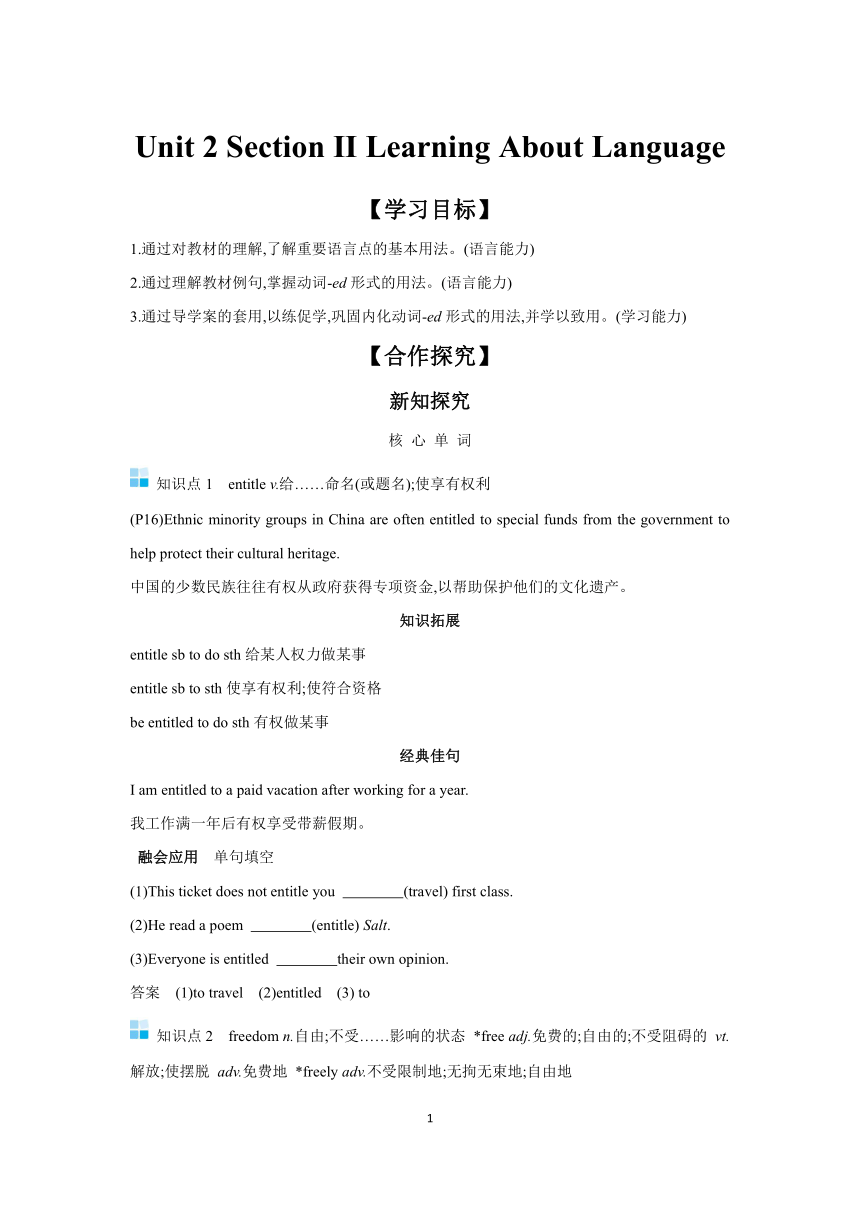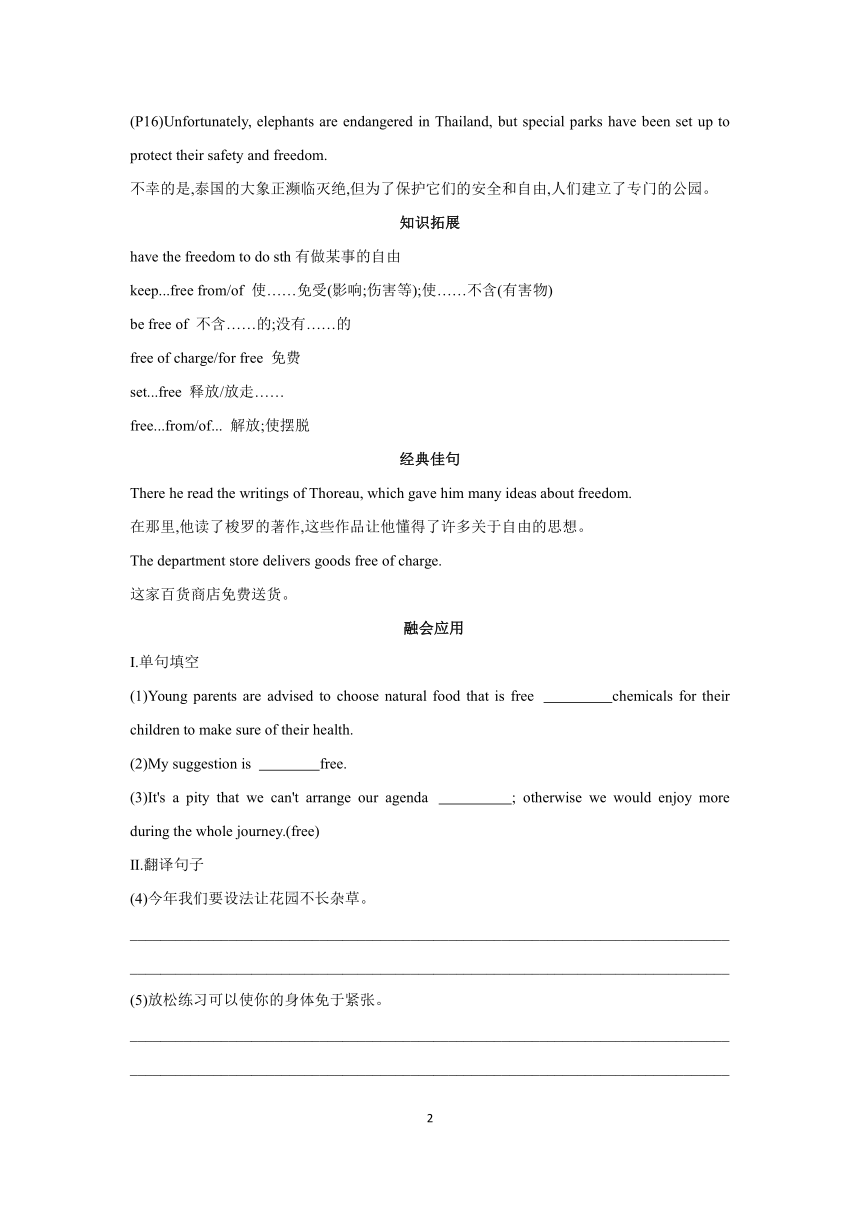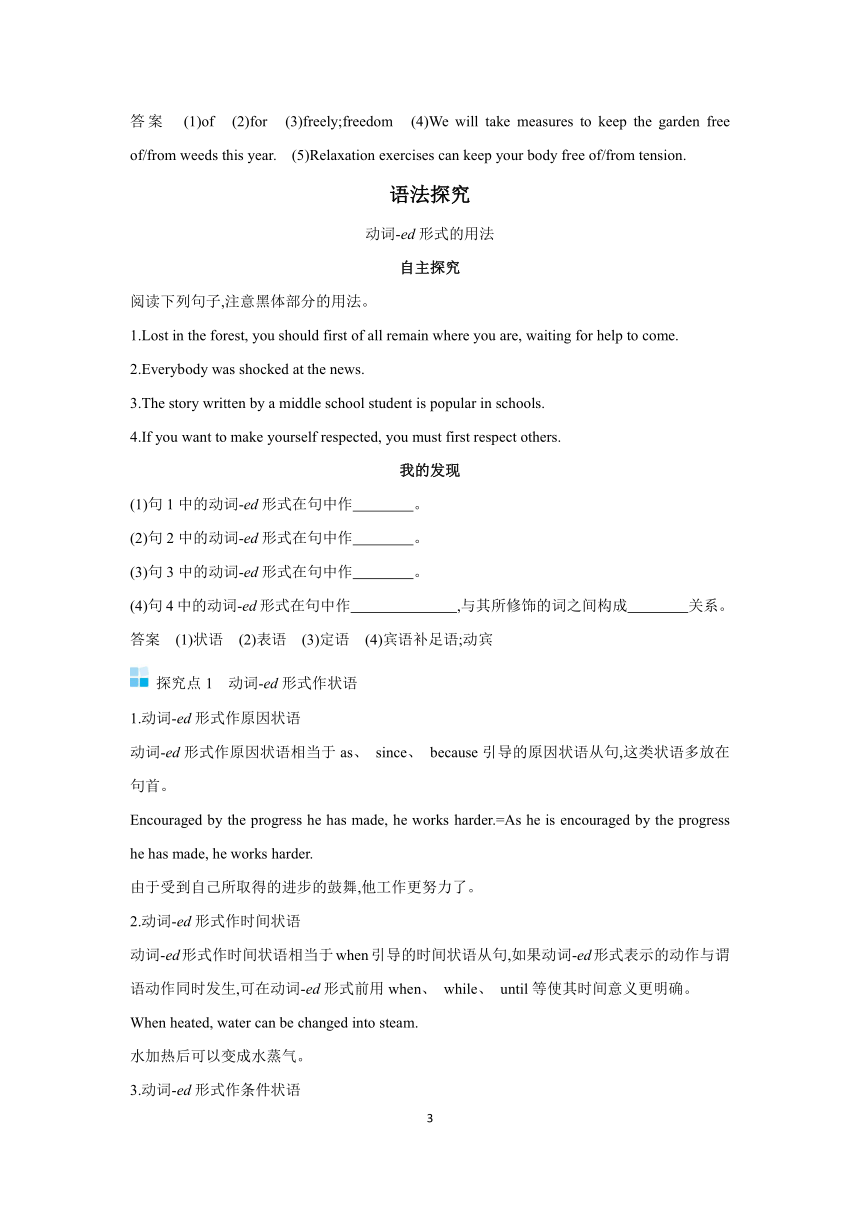人教版(2019)选择性必修 第四册Unit 2 Iconic Attractions Learning About Language 学案(含答案)
文档属性
| 名称 | 人教版(2019)选择性必修 第四册Unit 2 Iconic Attractions Learning About Language 学案(含答案) |  | |
| 格式 | docx | ||
| 文件大小 | 29.3KB | ||
| 资源类型 | 教案 | ||
| 版本资源 | 人教版(2019) | ||
| 科目 | 英语 | ||
| 更新时间 | 2024-04-07 16:37:51 | ||
图片预览



文档简介
Unit 2 Section Ⅱ Learning About Language
【学习目标】
1.通过对教材的理解,了解重要语言点的基本用法。(语言能力)
2.通过理解教材例句,掌握动词-ed形式的用法。(语言能力)
3.通过导学案的套用,以练促学,巩固内化动词-ed形式的用法,并学以致用。(学习能力)
【合作探究】
新知探究
核 心 单 词
知识点1 entitle v.给……命名(或题名);使享有权利
(P16)Ethnic minority groups in China are often entitled to special funds from the government to help protect their cultural heritage.
中国的少数民族往往有权从政府获得专项资金,以帮助保护他们的文化遗产。
知识拓展
entitle sb to do sth给某人权力做某事
entitle sb to sth使享有权利;使符合资格
be entitled to do sth有权做某事
经典佳句
I am entitled to a paid vacation after working for a year.
我工作满一年后有权享受带薪假期。
融会应用 单句填空
(1)This ticket does not entitle you (travel) first class.
(2)He read a poem (entitle) Salt.
(3)Everyone is entitled their own opinion.
答案 (1)to travel (2)entitled (3) to
知识点2 freedom n.自由;不受……影响的状态 *free adj.免费的;自由的;不受阻碍的 vt.解放;使摆脱 adv.免费地 *freely adv.不受限制地;无拘无束地;自由地
(P16)Unfortunately, elephants are endangered in Thailand, but special parks have been set up to protect their safety and freedom.
不幸的是,泰国的大象正濒临灭绝,但为了保护它们的安全和自由,人们建立了专门的公园。
知识拓展
have the freedom to do sth有做某事的自由
keep...free from/of 使……免受(影响;伤害等);使……不含(有害物)
be free of 不含……的;没有……的
free of charge/for free 免费
set...free 释放/放走……
free...from/of... 解放;使摆脱
经典佳句
There he read the writings of Thoreau, which gave him many ideas about freedom.
在那里,他读了梭罗的著作,这些作品让他懂得了许多关于自由的思想。
The department store delivers goods free of charge.
这家百货商店免费送货。
融会应用
Ⅰ.单句填空
(1)Young parents are advised to choose natural food that is free chemicals for their children to make sure of their health.
(2)My suggestion is free.
(3)It's a pity that we can't arrange our agenda ; otherwise we would enjoy more during the whole journey.(free)
Ⅱ.翻译句子
(4)今年我们要设法让花园不长杂草。
_______________________________________________________________________________
_______________________________________________________________________________
(5)放松练习可以使你的身体免于紧张。
_______________________________________________________________________________
_______________________________________________________________________________
答案 (1)of (2)for (3)freely;freedom (4)We will take measures to keep the garden free of/from weeds this year. (5)Relaxation exercises can keep your body free of/from tension.
语法探究
动词-ed形式的用法
自主探究
阅读下列句子,注意黑体部分的用法。
1.Lost in the forest, you should first of all remain where you are, waiting for help to come.
2.Everybody was shocked at the news.
3.The story written by a middle school student is popular in schools.
4.If you want to make yourself respected, you must first respect others.
我的发现
(1)句1中的动词-ed形式在句中作 。
(2)句2中的动词-ed形式在句中作 。
(3)句3中的动词-ed形式在句中作 。
(4)句4中的动词-ed形式在句中作 ,与其所修饰的词之间构成 关系。
答案 (1)状语 (2)表语 (3)定语 (4)宾语补足语;动宾
探究点1 动词-ed形式作状语
1.动词-ed形式作原因状语
动词-ed形式作原因状语相当于as、 since、 because引导的原因状语从句,这类状语多放在句首。
Encouraged by the progress he has made, he works harder.=As he is encouraged by the progress he has made, he works harder.
由于受到自己所取得的进步的鼓舞,他工作更努力了。
2.动词-ed形式作时间状语
动词-ed形式作时间状语相当于when引导的时间状语从句,如果动词-ed形式表示的动作与谓语动作同时发生,可在动词-ed形式前用when、 while、 until等使其时间意义更明确。
When heated, water can be changed into steam.
水加热后可以变成水蒸气。
3.动词-ed形式作条件状语
动词-ed形式作条件状语相当于if、 unless引导的条件状语从句。
Some medicines,wrongly taken,can kill a person.=Some medicines,if they are wrongly taken,can kill a person.
有些药物如果被误食,能致人死亡。
4.动词-ed形式作伴随状语
The teacher came in, followed by his students.
老师进来了, 后面跟着他的学生。
She sat by the window, lost in thought.
她坐在窗前,陷入沉思。
5.动词-ed形式作让步状语
动词-ed形式作让步状语,相当于although、 though引导的让步状语从句。
Exhausted by the climb, we continued our journey. =Although we were exhausted by the climb, we continued our journey.
我们虽然爬得很累,但仍然继续我们的旅程。
Much tired, he still kept on working.=Though he was tired, he still kept on working.
尽管他很累,但他仍然继续工作。
名师点拨
1.动词-ed形式作时间、条件、原因、让步等状语时,可转换为对应的状语从句。
Questioned by the police about the fire, the man became tense.
→The man became tense when he was questioned by the police about the fire.
Written in a hurry, this article was not so good.
→As it was written in a hurry, this article was not so good.
2.动词-ed形式作状语,前面可以加when、 while、 if、 unless、 once、 though等连词,构成“连词+分词”形式。
Though warned of the danger, he still went skating on the thin ice.
3.动词-ed形式作状语时,与句子的主语之间存在逻辑上的动宾关系;动词-ing形式作状语时,与句子的主语之间存在逻辑上的主谓关系。试比较:
Seen from the top of the tower, our city looks very beautiful.
Seeing from the top of the tower, we can get a wonderful view of the city.
4.动词-ed形式作状语时,其逻辑主语与句子的主语要一致。
[误]Given another chance, the job could be better done.
[正]Given another chance, I could do the job better.
再给我一次机会,我可以把这项工作做得更好。
融会应用 单句填空
(1) (leave) on the bed, the hungry baby began to cry.
(2)Sally accepted the gift from her boyfriend, deeply (move).
(3)We went to the cinema, (fill) with excitement.
答案 (1)Left (2)moved (3)filled
探究点2 动词-ed形式作定语
动词-ed形式作定语时,表示的动作在谓语动词所表示的动作之前发生,已经完成并具有被动意义。此时,作定语的动词-ed形式一般是由及物动词转化而来,因为只有此类动词的动词-ed形式才有被动意义。
●不及物动词的动词-ed形式也可作定语,一般作前置定语,不表示被动意义,只强调动作的状态或完成。如:fallen leaves“落叶”;retired workers“退休工人”;the risen sun“升起的太阳”。
●动词-ed形式有时还可用作非限制性定语,相当于一个非限制性定语从句,前后用逗号分开。
Some of them, born and brought up in rural villages, had never seen a train.
他们中的一些人,出生并生长在农村,从来没有见过火车。
●动词-ed形式与动词-ing形式作定语时的区别:
动词-ing形式作定语时与所修饰的名词之间是逻辑上的主谓关系,表示动作正在进行;而动词-ed形式作定语时,则表示被动或完成意义。
The girl standing under the tree is really charming. 站在树下的那个女孩真的很迷人。
Mr Smith, tired of the boring soap opera, started to read a novel.
史密斯先生厌倦了无聊的肥皂剧,开始看起了小说。
融会应用
Ⅰ.单句填空
(1)Some of the people (invite) to the party can't come.
(2)The trees (blow) down in the storm have been moved off the road.
(3)The police will come soon to take away the (damage) car.
Ⅱ.用动词-ed形式将下面的句子改为简单句
(4)Most of the people who had been questioned were students.
→____________________________________________________________________________
(5)Do you know the number of books which have been ordered
→____________________________________________________________________________
答案 (1)invited (2)blown (3)damaged (4)Most of the people questioned were students. (5)Do you know the number of books ordered
探究点3 动词-ed形式作表语
1.基本用法
动词-ed形式可放在连系动词be、remain、get、feel、seem、look、become等之后作表语,构成“主系表”结构,表示主语的状态。
She is quite satisfied with the design of the dress.
她对这条裙子的款式很满意。
注意:很多作表语的动词-ed形式已经具备了形容词的性质,如tired、 amused、 pleased等。
2.动词-ed形式作表语与被动语态的区别
动词-ed形式作表语表示主语的状态,常在be、 get、 remain等系动词后;而被动语态则表示被动的动作,由助动词be(有时也用get)加动词-ed形式构成,后面可由by引出动作的执行者。
The window is broken.
窗户破了。(表示状态)
The window was broken by Tom.
窗户被汤姆打破了。(表示动作)
注意:被动语态常由much、greatly等副词修饰,而系表结构常由very、 quite、 rather、 too、 so等副词修饰。
融会应用 单句填空
(1)Anne was too (tire) to walk any further.
(2)When Helen heard the story, she was deeply .(move)
(3)Tim was more (surprise) than (disappoint) at this news.
(4)Both my English teacher and I are (satisfy) with the result.
答案 (1)tired (2)moving;moved (3)surprised;disappointed (4)satisfied
探究点4 动词-ed形式作宾语补足语
动词-ed形式可以跟在感官动词see、 hear、 notice、 watch、 feel, 使役动词get、 have、 make、 leave、 keep以及介词with等词后,与名词或代词一起构成复合宾语,常用作宾语补足语,与宾语在逻辑上是动宾关系。
He found his hometown greatly changed.
他发现他的家乡发生了很大的变化。
When will you go to the hospital and have your tooth examined
你什么时候去医院检查你的牙齿
融会应用 单句填空
(1)You'd better have your shoes (mend).
(2)I saw an old man (knock) down by a car.
答案 (1)mended (2)knocked
2
【学习目标】
1.通过对教材的理解,了解重要语言点的基本用法。(语言能力)
2.通过理解教材例句,掌握动词-ed形式的用法。(语言能力)
3.通过导学案的套用,以练促学,巩固内化动词-ed形式的用法,并学以致用。(学习能力)
【合作探究】
新知探究
核 心 单 词
知识点1 entitle v.给……命名(或题名);使享有权利
(P16)Ethnic minority groups in China are often entitled to special funds from the government to help protect their cultural heritage.
中国的少数民族往往有权从政府获得专项资金,以帮助保护他们的文化遗产。
知识拓展
entitle sb to do sth给某人权力做某事
entitle sb to sth使享有权利;使符合资格
be entitled to do sth有权做某事
经典佳句
I am entitled to a paid vacation after working for a year.
我工作满一年后有权享受带薪假期。
融会应用 单句填空
(1)This ticket does not entitle you (travel) first class.
(2)He read a poem (entitle) Salt.
(3)Everyone is entitled their own opinion.
答案 (1)to travel (2)entitled (3) to
知识点2 freedom n.自由;不受……影响的状态 *free adj.免费的;自由的;不受阻碍的 vt.解放;使摆脱 adv.免费地 *freely adv.不受限制地;无拘无束地;自由地
(P16)Unfortunately, elephants are endangered in Thailand, but special parks have been set up to protect their safety and freedom.
不幸的是,泰国的大象正濒临灭绝,但为了保护它们的安全和自由,人们建立了专门的公园。
知识拓展
have the freedom to do sth有做某事的自由
keep...free from/of 使……免受(影响;伤害等);使……不含(有害物)
be free of 不含……的;没有……的
free of charge/for free 免费
set...free 释放/放走……
free...from/of... 解放;使摆脱
经典佳句
There he read the writings of Thoreau, which gave him many ideas about freedom.
在那里,他读了梭罗的著作,这些作品让他懂得了许多关于自由的思想。
The department store delivers goods free of charge.
这家百货商店免费送货。
融会应用
Ⅰ.单句填空
(1)Young parents are advised to choose natural food that is free chemicals for their children to make sure of their health.
(2)My suggestion is free.
(3)It's a pity that we can't arrange our agenda ; otherwise we would enjoy more during the whole journey.(free)
Ⅱ.翻译句子
(4)今年我们要设法让花园不长杂草。
_______________________________________________________________________________
_______________________________________________________________________________
(5)放松练习可以使你的身体免于紧张。
_______________________________________________________________________________
_______________________________________________________________________________
答案 (1)of (2)for (3)freely;freedom (4)We will take measures to keep the garden free of/from weeds this year. (5)Relaxation exercises can keep your body free of/from tension.
语法探究
动词-ed形式的用法
自主探究
阅读下列句子,注意黑体部分的用法。
1.Lost in the forest, you should first of all remain where you are, waiting for help to come.
2.Everybody was shocked at the news.
3.The story written by a middle school student is popular in schools.
4.If you want to make yourself respected, you must first respect others.
我的发现
(1)句1中的动词-ed形式在句中作 。
(2)句2中的动词-ed形式在句中作 。
(3)句3中的动词-ed形式在句中作 。
(4)句4中的动词-ed形式在句中作 ,与其所修饰的词之间构成 关系。
答案 (1)状语 (2)表语 (3)定语 (4)宾语补足语;动宾
探究点1 动词-ed形式作状语
1.动词-ed形式作原因状语
动词-ed形式作原因状语相当于as、 since、 because引导的原因状语从句,这类状语多放在句首。
Encouraged by the progress he has made, he works harder.=As he is encouraged by the progress he has made, he works harder.
由于受到自己所取得的进步的鼓舞,他工作更努力了。
2.动词-ed形式作时间状语
动词-ed形式作时间状语相当于when引导的时间状语从句,如果动词-ed形式表示的动作与谓语动作同时发生,可在动词-ed形式前用when、 while、 until等使其时间意义更明确。
When heated, water can be changed into steam.
水加热后可以变成水蒸气。
3.动词-ed形式作条件状语
动词-ed形式作条件状语相当于if、 unless引导的条件状语从句。
Some medicines,wrongly taken,can kill a person.=Some medicines,if they are wrongly taken,can kill a person.
有些药物如果被误食,能致人死亡。
4.动词-ed形式作伴随状语
The teacher came in, followed by his students.
老师进来了, 后面跟着他的学生。
She sat by the window, lost in thought.
她坐在窗前,陷入沉思。
5.动词-ed形式作让步状语
动词-ed形式作让步状语,相当于although、 though引导的让步状语从句。
Exhausted by the climb, we continued our journey. =Although we were exhausted by the climb, we continued our journey.
我们虽然爬得很累,但仍然继续我们的旅程。
Much tired, he still kept on working.=Though he was tired, he still kept on working.
尽管他很累,但他仍然继续工作。
名师点拨
1.动词-ed形式作时间、条件、原因、让步等状语时,可转换为对应的状语从句。
Questioned by the police about the fire, the man became tense.
→The man became tense when he was questioned by the police about the fire.
Written in a hurry, this article was not so good.
→As it was written in a hurry, this article was not so good.
2.动词-ed形式作状语,前面可以加when、 while、 if、 unless、 once、 though等连词,构成“连词+分词”形式。
Though warned of the danger, he still went skating on the thin ice.
3.动词-ed形式作状语时,与句子的主语之间存在逻辑上的动宾关系;动词-ing形式作状语时,与句子的主语之间存在逻辑上的主谓关系。试比较:
Seen from the top of the tower, our city looks very beautiful.
Seeing from the top of the tower, we can get a wonderful view of the city.
4.动词-ed形式作状语时,其逻辑主语与句子的主语要一致。
[误]Given another chance, the job could be better done.
[正]Given another chance, I could do the job better.
再给我一次机会,我可以把这项工作做得更好。
融会应用 单句填空
(1) (leave) on the bed, the hungry baby began to cry.
(2)Sally accepted the gift from her boyfriend, deeply (move).
(3)We went to the cinema, (fill) with excitement.
答案 (1)Left (2)moved (3)filled
探究点2 动词-ed形式作定语
动词-ed形式作定语时,表示的动作在谓语动词所表示的动作之前发生,已经完成并具有被动意义。此时,作定语的动词-ed形式一般是由及物动词转化而来,因为只有此类动词的动词-ed形式才有被动意义。
●不及物动词的动词-ed形式也可作定语,一般作前置定语,不表示被动意义,只强调动作的状态或完成。如:fallen leaves“落叶”;retired workers“退休工人”;the risen sun“升起的太阳”。
●动词-ed形式有时还可用作非限制性定语,相当于一个非限制性定语从句,前后用逗号分开。
Some of them, born and brought up in rural villages, had never seen a train.
他们中的一些人,出生并生长在农村,从来没有见过火车。
●动词-ed形式与动词-ing形式作定语时的区别:
动词-ing形式作定语时与所修饰的名词之间是逻辑上的主谓关系,表示动作正在进行;而动词-ed形式作定语时,则表示被动或完成意义。
The girl standing under the tree is really charming. 站在树下的那个女孩真的很迷人。
Mr Smith, tired of the boring soap opera, started to read a novel.
史密斯先生厌倦了无聊的肥皂剧,开始看起了小说。
融会应用
Ⅰ.单句填空
(1)Some of the people (invite) to the party can't come.
(2)The trees (blow) down in the storm have been moved off the road.
(3)The police will come soon to take away the (damage) car.
Ⅱ.用动词-ed形式将下面的句子改为简单句
(4)Most of the people who had been questioned were students.
→____________________________________________________________________________
(5)Do you know the number of books which have been ordered
→____________________________________________________________________________
答案 (1)invited (2)blown (3)damaged (4)Most of the people questioned were students. (5)Do you know the number of books ordered
探究点3 动词-ed形式作表语
1.基本用法
动词-ed形式可放在连系动词be、remain、get、feel、seem、look、become等之后作表语,构成“主系表”结构,表示主语的状态。
She is quite satisfied with the design of the dress.
她对这条裙子的款式很满意。
注意:很多作表语的动词-ed形式已经具备了形容词的性质,如tired、 amused、 pleased等。
2.动词-ed形式作表语与被动语态的区别
动词-ed形式作表语表示主语的状态,常在be、 get、 remain等系动词后;而被动语态则表示被动的动作,由助动词be(有时也用get)加动词-ed形式构成,后面可由by引出动作的执行者。
The window is broken.
窗户破了。(表示状态)
The window was broken by Tom.
窗户被汤姆打破了。(表示动作)
注意:被动语态常由much、greatly等副词修饰,而系表结构常由very、 quite、 rather、 too、 so等副词修饰。
融会应用 单句填空
(1)Anne was too (tire) to walk any further.
(2)When Helen heard the story, she was deeply .(move)
(3)Tim was more (surprise) than (disappoint) at this news.
(4)Both my English teacher and I are (satisfy) with the result.
答案 (1)tired (2)moving;moved (3)surprised;disappointed (4)satisfied
探究点4 动词-ed形式作宾语补足语
动词-ed形式可以跟在感官动词see、 hear、 notice、 watch、 feel, 使役动词get、 have、 make、 leave、 keep以及介词with等词后,与名词或代词一起构成复合宾语,常用作宾语补足语,与宾语在逻辑上是动宾关系。
He found his hometown greatly changed.
他发现他的家乡发生了很大的变化。
When will you go to the hospital and have your tooth examined
你什么时候去医院检查你的牙齿
融会应用 单句填空
(1)You'd better have your shoes (mend).
(2)I saw an old man (knock) down by a car.
答案 (1)mended (2)knocked
2
